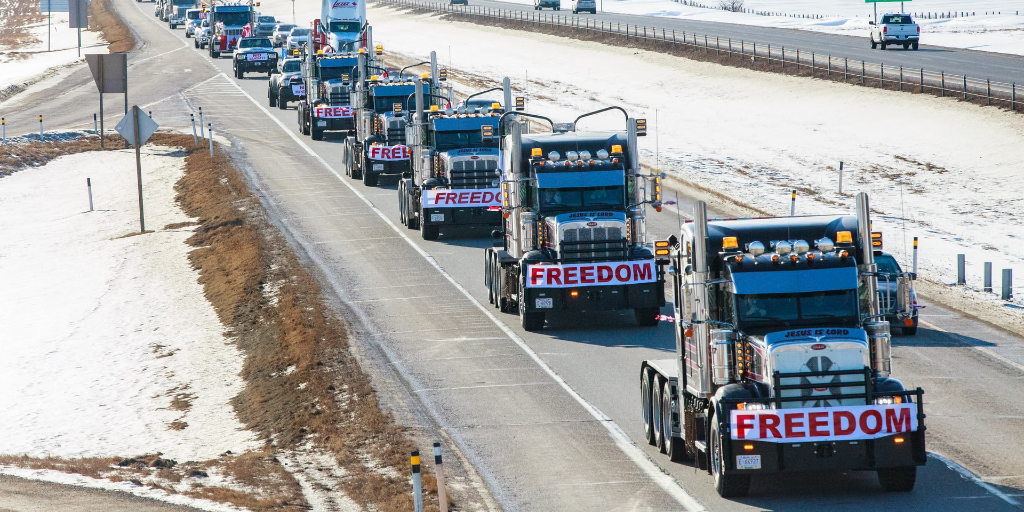Now here’s a strange reversal of roles. Canada is having a cultural meltdown and the U.S. is pleading for calm.
Lesson summary
Hi there everyone, it’s Jeff and this is Plain English, where JR and I help you upgrade your English with current events and trending topics. JR has uploaded the full lesson to PlainEnglish.com/448.
Coming up today: Canada has experienced its largest protests against COVID-19 restrictions, as thousands of truckers and their sympathizers took over Ottawa, the capital, and shut down a major bridge between Ontario and Detroit. We have an expression today, and that is “in droves.” And I have a quote of the week for you too. Let’s get going.
Canada’s ‘Freedom Convoy’ and the vaccine mandate
Truckers in Canada are fed up with the country’s measures against COVID-19, and they made their voices (and horns) heard.
It all started when a group of truckers drove from Canada’s western provinces to the capital, Ottawa, Ontario. Their purpose was to protest the new rules for people crossing the border with the United States. Canada’s government said that anyone who crosses the border must be vaccinated, or quarantine for 14 days.
That’s not exactly a requirement that all international truckers be vaccinated, but it’s close. No international truck driver could make a living by frequently self-quarantining for two weeks at a time. It was effectively a vaccine mandate for cross-border truckers.
Most truckers are vaccinated; some estimates say that over 90 percent are. But some thought this mandate was the last straw; they felt the Canadian government was overreaching with its pandemic restrictions, especially now that case loads are decreasing and that COVID-19 is increasingly under control.
As the protesting truckers gained attention, other Canadians—not truckers—sympathized with them and joined the protests. Many of the new protesters were vaccinated themselves, but disapproved of the continuing rules and restrictions the Canadian government was putting on citizens.
The protesters went to Freedom Hill, the legislative seat of the Canadian Parliament in Ottawa. They called themselves the “Freedom Convoy” and they arrived in downtown Ottawa in droves . More than four thousand vehicles and around 15,000 demonstrators amassed around the Parliamentary district for a mass rally. Demonstrators decked out in the Canadian flag and other patriotic gear swarmed the streets of Ottawa, bearing placards calling for an end to vaccine mandates and other restrictions, along with calls for the prime minister to resign.
This had a big impact. Ottawa is only the sixth-largest city in Canada, with a population of around a million people. Canadians are pretty agreeable and their politics are not typically divisive by world standards, so Ottawa is not used to mass demonstrations.
The police force was overwhelmed. The costs for the added policing in Ottawa due to “Truckagedon” are in the region of $800,000 a day. Ottawa officials have also said that the city has spent a lot of additional money on other city services due to the protests. The chief of the Ottawa Police Force was forced to resign over his handling of the protests.
Vehicles were blasting their horns and idling their engines day and night. Locals, many of whom are still working at home, found they couldn’t sleep at night or concentrate on their work during the day. They said they felt like the victims of psychological warfare. Businesses were hurt since so many locals stayed home. A judge banned the use of horns in downtown.
And then on February 7, the Freedom Convoy tried a new tactic: they erected a blockade at the Ambassador Bridge, linking Windsor, Ontario to Detroit, Michigan. This bridge is North America’s busiest international border crossing. The car making industry is so tightly integrated that people in the industry consider Ontario and Michigan to be one region. About a quarter of all U.S.-Canadian trade crosses this bridge. And the Freedom Convoy blocked it with just six trucks and a few hundred protesters.
If the Ottawa protests were an inconvenience, this was a major disruption across many industries. The car making industry was hit the hardest. Ford had to stop its auto assembly line in Windsor. Toyota closed three plants across Ontario, and General Motors cut shifts in Michigan. And this came at a bad time, because the auto industry was already struggling with a shortage of computer chips and other supply chain disruptions. Similar protests were erected at other, smaller border crossings, too.
This caught the attention of American President Joe Biden, who expressed his discontent with the disruptions on the Canadian side of the border.
Canadian police had been reluctant to make arrests and use force to disperse protesters. But they started to get serious with the blockade. They arrested 46 people at the Ambassador Bridge. Six days after the blockade started, the bridge was open for business again. A similar thing happened at the other border crossings that were blocked. Most of the protesters in Ottawa, too, have gone home, and police are trying to clear out those who remain.
A strange role reversal
I felt like I was living in an alternate universe. Canada—Canada!—was having a political meltdown and a U.S. president was pleading for calm. What world are we living in?
Canada tends to have more centrist politics. Even the opposition party in Canada mostly went along with the actions of the government during COVID. But I think this is showing the struggle that many countries are having, moving from the pandemic mindset to the endemic mindset.
At the beginning, in Canada, the broad opinion was, “We’re in this together, we’ll make a community sacrifice.” But now, since almost everyone is vaccinated, and cases are lower, the impact is lower, the question is, how much of those initial sacrifices do we have to continue making, possibly for a long time in the future?
Great stories make learning English fun

